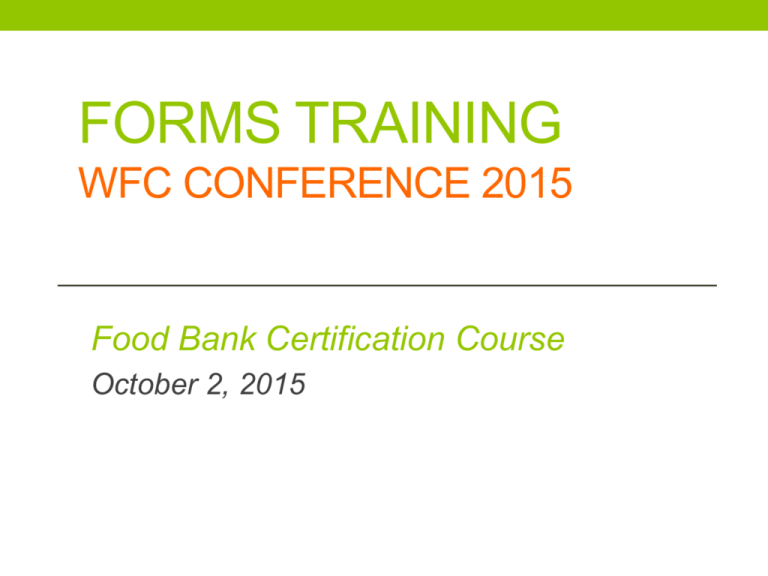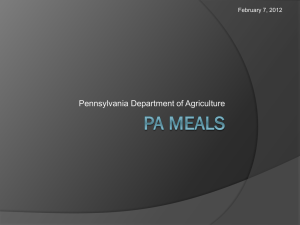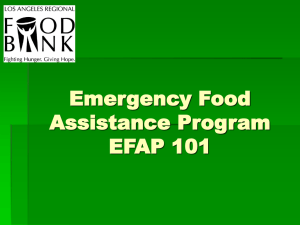Forms Training WFC Conference
advertisement

FORMS TRAINING WFC CONFERENCE 2015 Food Bank Certification Course October 2, 2015 Welcome & Introductions • Presenters: • Trish Twomey, Washington Food Coalition • Stephanie Hsu, Partner Programs Coordinator, Northwest Harvest • Rosemary Rankins, Agency Relations Manager, Food Lifeline • James Scovel, Program Coordinator, Food Assistance Programs – WSDA • Megan Harlan, Program Coordinator, Food Assistance Programs – WSDA • Review Agenda: Handouts: • ABC Sheet • When reports are due • Other handouts from presenters Who Are You? Workshop attendees: • How many of you are a: • Food pantry? • EFAP Lead Agency contractor for WSDA? • Tribal Food Voucher Contractor? How many of you receive: • EFAP Funding and/or food? • TEFAP food? TEFAP funding? • CSFP food? • Food from NW Harvest? • Food from Second Harvest Inland NW? • Food Lifeline? Important Definitions: See handout • Duplicated count – A household makes a repeat or return visit to your food bank after their first initial visit of the year, they are considered a duplicated household for each and every subsequent visit during the reporting year. • Unduplicated count - the very first visit to the food bank during the reporting year. • Special Dietary Needs - The number of individuals served with “special dietary needs” foods, whether or not these foods were purchased out of EFAP “Special Dietary Needs Funds.” See specific definition. • Reporting year - This is the 12-month period of food bank activity that begins in either January or July, depending on the reporting requirements of food bank funders or food distributors. Lets look at report forms Northwest Harvest - Stephanie • Mission: to provide nutritious food to hungry people statewide in a manner that respects their dignity, while working to eliminate hunger. • Statewide, over 370 programs • Free food with focus on high nutritional value • Three Squares, Kids Summer Food Club, Growing Connections, Holiday Protein and Smart Buys Food Lifeline – Rosemary • Seattle’s Table: rescues otherwise wasted prepared food from local restaurants, caterers, corporate dining rooms, universities, convention centers, hospitals, grocery stores, and other food service providers. Distributes this food to meal programs and shelters. • Kids Café: provides free snacks and meals to youth ages 1-18 outside school hours at sites where they live, learn and play. Through the USDA’s Summer Food Service Program and Child and Adult Care Food Program, we purchase food, do menu planning, and administrative paperwork to help fill gaps in communities across Western Washington. • Grocery Rescue: rescues perishable food products from local grocery stores in order to increase the volume and variety of food available to meal programs and food banks. Stores include QFC, Fred Meyer, Albertson’s, and Wal-Mart. Food Lifeline (cont.) • Order Up! – food purchasing program in which Food Lifeline buys bulk quantities of products from vendors at a significantly discounted price and offers these products to agencies at cost plus a minimal mark-up to sustain the program. • Order Up! Products may be ordered through the online ordering system along with other donations regularly ordered each week by agencies. Food Lifeline’s MARS On-line reporting form WA State Department of Agriculture – James The Food Safety & Consumer Services Division contains the 3 emergency food programs: • The Emergency Food Assistance Program (TEFAP) • Commodity Supplemental Food Program (CSFP) • Emergency Food Assistance Program (EFAP) WSDA TEFAP is a federal program that provides an allocation of operating funds and food to meal programs and food pantries in each county by formula. Low income people are eligible to receive the food. CSFP is also a federal program that provides food and operating funds to providers in 21 of the 39 counties in the state according to caseload size. Low-income seniors are eligible to receive the food. TEFAP Report - James TEFAP Inventory Report Reports are due to contractors monthly. Expectation is that food pantries and meal programs will do a physical count of food every month so that you know how much product you gave out and how much you still have at the beginning of every month. If you have more than 2-3 months of a product, develop a way to distribute it (e.g. give more out to each family), call your contractor to get ideas or have the product redistributed elsewhere. Do not keep product for over 3 months! Never give out food that is past its “Use by”, “Best if used by” or expiration date. TEFAP Inventory Report, con’t Food Pantry and Meal Programs: Fill out Month/Year, agency name, person’s name filling out form. Food Pantries: Required to list client signatures (families) and Total Household Members (# of individuals in family). Meal Programs: Is optional to report # of meals served. Ask contractor if they would like that information. Inventory, both food pantries and meal programs (report in cases): Beginning inventory of cases you had on the 1st of each product. TEFAP Inventory Report, con’t Received: # of cases you received of each product. Total: Beginning inventory + received. Will automatically calculate in electronic form. Issued: For meal programs, what you used to prepare meals, for food pantries what you gave out to clients. Damaged or Loss: If any items were damaged or appear to be missing these must be reported. Call your contractor for follow-up process. Positive or Negative Adjustment: If the numbers don’t add up and there are more or fewer items than the numbers show, insert the number over or under. Book Inventory: According to totals above, what is left still in your inventory. TEFAP Inventory Report, con’t Physical Inventory: Your totals of each items you get by actually counting the products. Over/Under: If the book inventory and physical inventory do not match, the difference in the two counts. Reason for damaged items or Positive/Negative Adjustment: To the best of your ability, briefly explain how the damage happened or why you think there may be adjustments. TEFAP Reimbursement Form TEFAP Reimbursement Form A TEFAP contractor may choose to pass on some of their funding to subcontractors to pay for their costs of distributing TEFAP. If you claim expenses, you must send documentation of your costs. Enter the contractor’s name and your agency’s name at the top of the form. In “Name” put the name of the person completing the form Enter agency’s address Sign in ink, preferably a color other than black, enter title and date completed. TEFAP Reimbursement Form For the expenditures, list each cost separately that you are going to charge to TEFAP. Date: The date the cost was incurred. Description: What was the expenditure? (salaries, benefits, printing, gasoline, etc.) Amount: For each billed cost. Emergency Food Assistance Program (EFAP) - Trish • Money for food pantries and food banks across WA State • Granted every two years. • Lead agency in each county. • Several types of subcontracts: • Cash reimbursement - food pantry is reimbursed directly for allowable expenditures. • Adequate accounting system, audit if meet criteria (if $500,000+ in federal funds or if $100,000+ in State funds). • Contractor pays bills for food pantries– vendor is paid directly by contractor, no funds are sent to food pantries. • Food/Supply – Food pantries get no money to spend. The food bank provides food to the food pantries. All the funds go to the food bank to supply food. EFAP (continued) Agencies must have match, 1:1 (100%) if at least 50% is cash match, or 2:1 (200%) of in-kind if don’t have sufficient cash match. All must follow Food Procurement Policy, have Liability Insurance, register with 211, have client eligibility and client privacy policies in place. EFAP reports are due monthly to your EFAP lead contractor. Contractors must submit their reports to WSDA summarizing all costs and data for their areas by the 20th of each month. All reports must be signed and include back-up documentation for all allowable costs being claimed. EFAP, Cont. Reimbursement contract – must have paid the bill and ask for reimbursement for the previous month unless contractor is paying the bill for you. Check your math! Make sure your data makes sense. Common errors: Reversing new and returning clients. Putting household numbers for client totals. Claiming expenses in the wrong month. Must be claimed in the month you paid the expense. Don’t leave money unspent at the end of the year! EFAP Report form Healthier Food Options - Megan Supports Governor’s Goal #4 Healthy and Safe Communities – Fostering the health of Washingtonians from a healthy start to a safe and supported future. Results Washington (www.results.wa.gov). Leading indicator for this goal is to increase the percentage of healthier food options offered to low income children and families through food pantries, farmers markets, and meal programs by 5% from 2014 through 2017. There are several ways we are currently using this data to support new programs. Healthier Food Option Report Questions & Answers ************************* Contacts for reports: • Food Lifeline – Rosemary Rankins Rosemaryr@fll.org • Northwest Harvest – Stephanie Hsu Stephanieh@northwestharvest.org • WSDA –Megan Harlan & James Scovel at MHarlan@agr.wa.gov & jscovel@arg.wa.gov • WFC – Trish Twomey, trish@wafoodcoalition.org Time for your exam!





